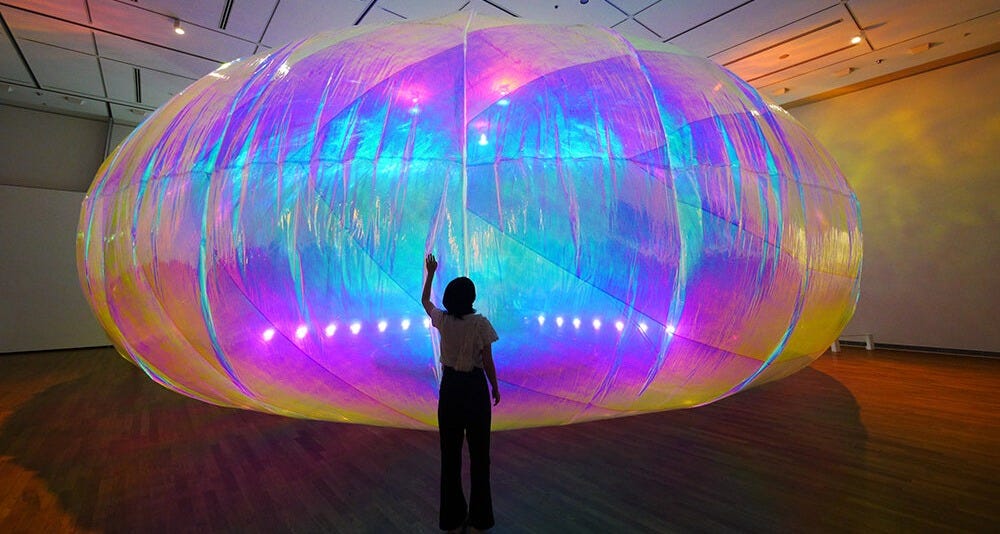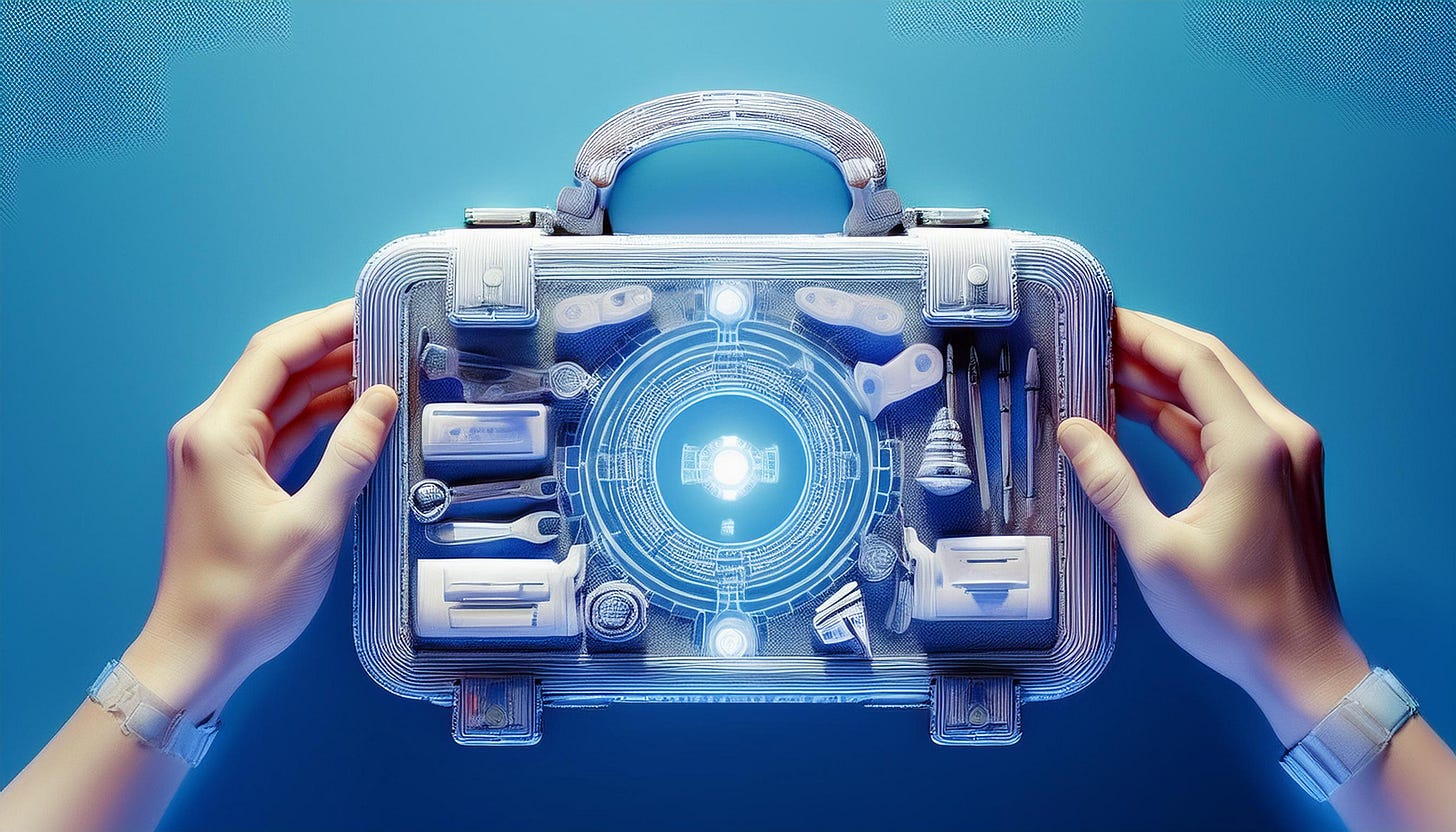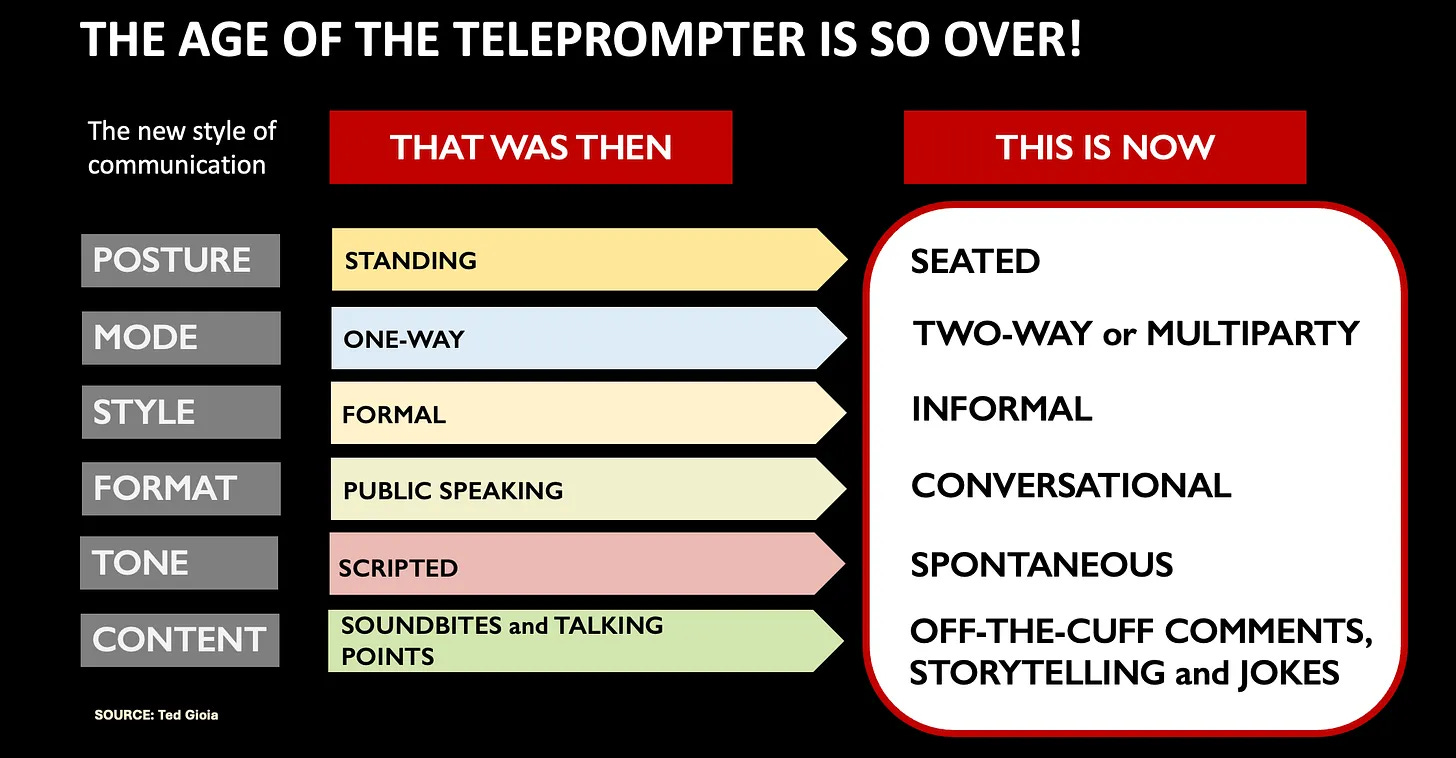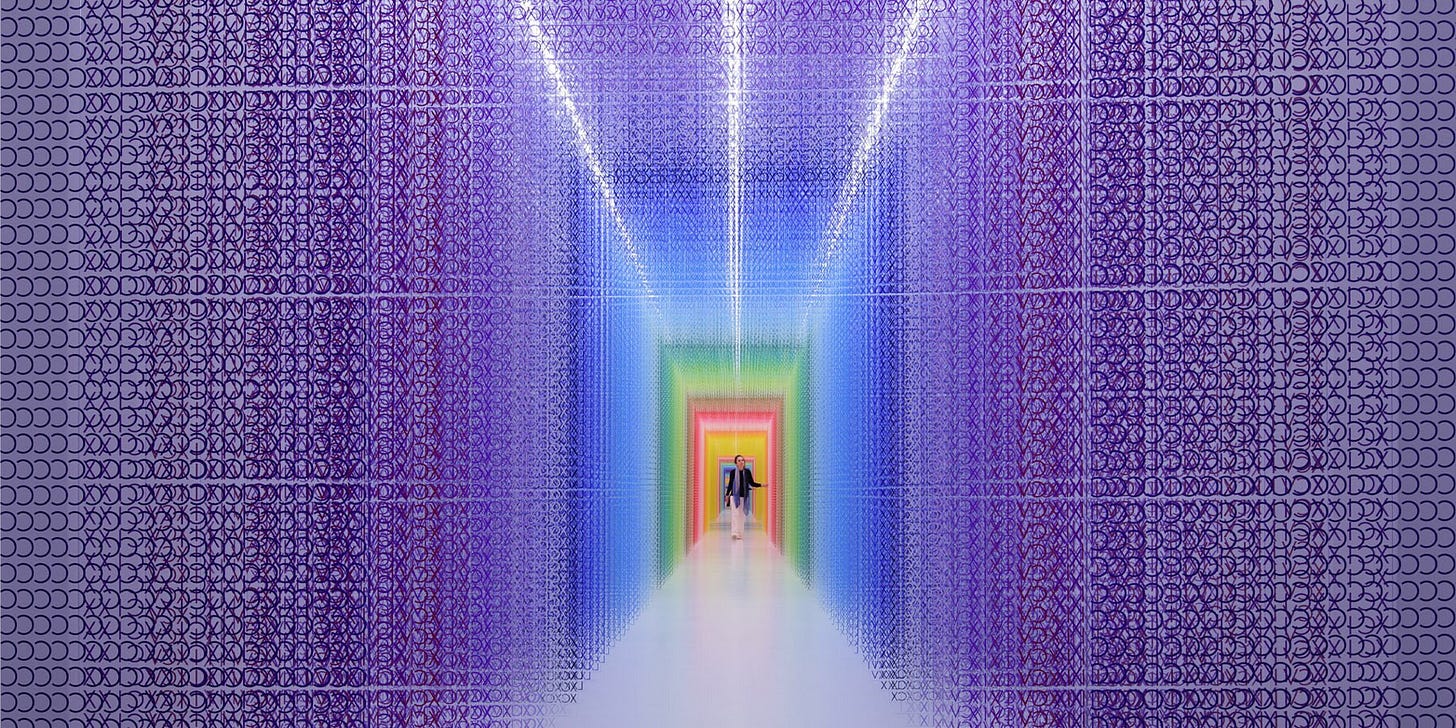The AI Toolkit for Teams — and Roundup #37
Plus: the new rules of communicating, competitive leisure, fog water harvesting, cloud milking, and more in Roundup #37

For the 37th time, welcome in!
New Logo, Same Newsletter
This time out, The New New has a new logo.
Out: my old mark, that I quickly pulled together years ago.
In: this new mark, designed by an actual human — my 14-year-old!
He made it in Blender, and I am, to be expected, obsessed with it. (He took a break from making awesome Apple parody ads to make this new mark.)
With the modeling power of Blender, you may see the logo come to life with motion and physical objects. Since “re-buttonization” is now the new new thing in design, there may be some The New New branded buttons made in the future.
Now, let’s get into this issue.
We kick off with a new framework I’ve been working on.
From there, we’ll scan through some points of intrigue, including a big scoop of perception, and then wrap it with a roundup of fascination.
Oh, and the word “scripted” is now an insult — dive in to see why.
The AI Toolkit for Teams
A practical framework for deploying AI across your organization
While business headlines are dominated by AI’s transformative potential in customer experiences and product development, it is AI’s ability to revolutionize internal operations and empower employees that is incredibly profound—and often overlooked.
While businesses of all types are racing to bring AI into their workforces—with many of them quoting Gartner’s AI TRiSM and building strategies with things like Bain’s AI Playbook—I find that there is still not a clear, strategic, yet practical playbook for bringing AI’s power to employees’ day-to-day work.
Enter this framework that lays the AI toolkit from which businesses can build their internal roadmaps for AI adoption:
AI General Applications:
These are the standalone apps that most knowledge workers have been trying out over the past few years, including ChatGPT and image generators.
Communication Platforms:
These platforms leverage AI to enhance collaboration and connectivity. For example, Zoom’s AI Assistant can automatically generate meeting summaries and action items.
Productivity Tools:
AI-driven applications streamline tasks and automate processes. Tools like Google Workspace’s Gemini or Grammarly can automatically generate documents, suggest edits, and prioritize tasks.
Specialized AI Applications:
These industry-specific tools address unique needs. For example, Jasper has become a super hot AI-powered tool for marketing teams.
Company-Built AI Applications:
Organizations can create custom AI solutions to address specific challenges. For instance, Opus Agency uses an AI-powered “Business Backgrounder” to help team members quickly ramp up new clients.
Employee-Built AI Applications:
Low-code development platforms empower employees to build custom AI tools tailored to their specific needs. For example, a data analyst might create an AI tool to automate data cleaning processes, while someone in sales enablement might create an AI tool for quickly generating RFI responses.
AI Agents:
These intelligent assistants automate tasks, provide information, and support users. For example, an AI agent could schedule meetings, answer questions, or provide product recommendations. (AI agents are the hottest things in tech at the moment. For a deeper dive into this trend, see these recent explorations from The Verge and Computerworld.)
While most organizations are still at Step 1, the path to maximizing Employee+AI effectiveness—the areas for tiered investment and purposeful experimentation—has come into focus.
Scan AheadInsightful scoops of perception, irreverent ideas, emerging narratives—these are the snippets that have stuck with me.
The 6 New Rules of Communicating
The word “scripted” is now an insult.
Ted Gioia is back with another big scoop of perception—this one exploring the shift in communication styles toward more informal and authentic interactions. Traditional, hierarchical forms of communication, such as formal speeches, are giving way to conversational and spontaneous exchanges.
These shifts reflect a societal preference for authenticity over polished rhetoric. Ted’s new rules include:
You gain more trust when seated, not standing.
Don’t speak at people—speak with them.
An informal tone is more persuasive now. Even leaders must adjust to this.
Conversations have more influence than speeches.
Spontaneous communications delivered from a personal standpoint are considered more ‘real’ than a script created by a team or speechwriter.
Soundbites and talking points are less impactful than storytelling, humor, and off-the-cuff comments.
These shifts are reshaping how leaders, educators, and public figures connect with their audiences, emphasizing the value of genuine, unscripted interactions in building trust and credibility. Take note.
Civilizational Anxiety
Understanding a shared unease.
Beneath the surface of daily life lies a growing tension—a collective unease about society’s direction and the challenges ahead.
This shared anxiety stems from concerns about instability and uncertainty and the need for greater resilience in the face of systemic challenges. Through this type of resiliency, we can all create pathways toward stronger connections, more thoughtful solutions, and a renewed sense of purpose for the future.
Competitive Leisure
When relaxation becomes a race.
In today’s digital age, activities meant for relaxation, such as reading or listening to music, are increasingly being transformed into competitive pursuits.
While platforms like Goodreads and Spotify Wrapped encourage users to set and share personal goals, these platforms are shifting us from enjoyment to performance tracking.
Together, this trend reflects a broader societal evolution in which leisure time is increasingly quantified and compared, potentially diminishing the intrinsic pleasure of these activities.
Automated Dining
What’s a vending machine and what’s a restaurant?
The rise of robots in restaurants is blurring the line between vending machines and dining experiences. With automated chefs, servers, and kiosks taking center stage, efficiency is soaring—but so are questions about what defines hospitality.
We’re all about to ask: How much automation will make a restaurant stop feeling like a restaurant?
The RoundupEveryday Upgrades
Next Velcro,
it is hard to explain what it really is. It’s not tape, not glue, not micro-hooks, not suction, and not electrically charged. It works like a gecko, using one-sided microhairs to adhere things together.
Unpaint,
paint designed to be removable – once dry, you can peel it off like plastic wrap without leaving behind any marks or residue (potentially perfect for renters to temporarily personalize their spaces easily).
Stretchable Displays,
twisting and expanding up to 50% more than its original size (super cool!).
Nature Reimagined
Cloud Milking,
a zero-energy technique to extract water from fog — it could revolutionize the recovery of forests devastated by fire and drought.
Scent Teleportation,
making it possible to capture a smell in one part of the world and diffuse it in another.
Okra Water,
move over lemon and cucumber, this plant is infusing water into a gel-like texture that may support smooth digestion.
Human Hacks
Exosome Explosion,
this trendy cure-all is being touted as a miraculous treatment for hair loss, aging skin, acne, eczema, pain conditions, long covid, and even neurological diseases like Parkinson’s and Alzheimer’s—but they are pricey and no one knows if they actually work.
Veneers,
spurred by technology advances, Hollywood trend following, and TikTok hype, they are now all the rage.
Genetic Discrimination,
gaps in existing laws are leaving people vulnerable to insurance denial or higher premiums based on genetic testing results.
Suspicious Friendliness,
rooting out what the retail industry calls “sweethearting,”—instances of store employees giving people they know discounts or free items.
Nostalgic Throw Backs
Pen-and-Ink Reservations,
top restaurants are eschewing apps like Resy and OpenTable, and even Instagram, rewinding to Luddite days of landlines and hulking reservation books.
Dumb Pagers,
move over dumb phones, Sega is bringing back the pager (and this time it is emoji-only).
IMG_0001,
between 2009 and 2012, iPhones’ “Send to YouTube” button created a digital time capsule of raw, unedited videos with default filenames like “IMG_XXXX.” Watching them is oddly enthralling.
Near-Future Nostalgia
It’s time for a bit of Nowstalgia—that feeling of nostalgia for the very recent past—we’re bringing it back from the issue that brought this idea forward.
Back in Issue 29, we also explored a sense of wonder about what’s just around the corner, including:
Indoor Solar Power:
What if your gadgets could charge themselves using just the light in your home?The AI Stack Wars:
Who’s winning the battle for AI dominance, and how will it shape the way we live and work?Robots & DIY Medicine:
Could tiny robots made from human cells become the future of personalized healthcare?Future-Forward Materials:
Can pineapple peels and immersive scent technology change how we think about fashion and entertainment?
This issue showed how quickly the future becomes the present and the not-so-distant past.
The New New’s mission is to fuel foresight. Every issue delivers a curated view into the discoveries, launches, trends, and movements shaping tomorrow—all explored through broad landscapes, from labs and studios to businesses and culture.
Each month(ish), this is pulled together by me, Brent Turner, and published on LinkedIn, Substack, and my site.
Okay, I’m off to try to learn Blender too.
- B
⌘




